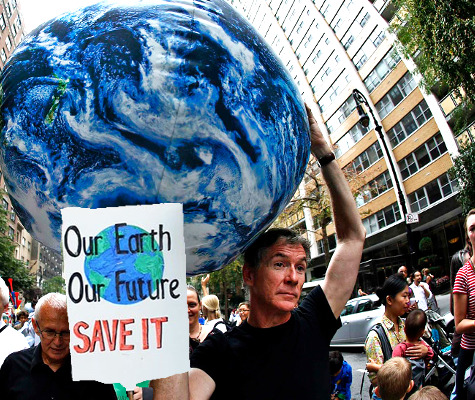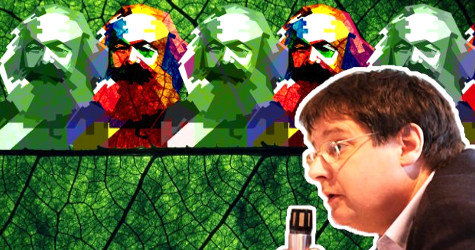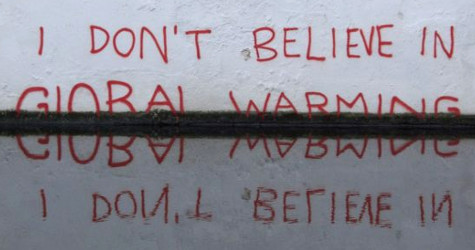Climate Change and Capitalism
The fifth report by the Intergovernmental Panel for Climate Change (IPCC) was released in 2013 (Climate Change 2013). The IPCC brings together hundreds of scientists in the field of climate change to cooperate in drawing up a comprehensive analysis of the state of the earth’s climate and forecasts about its future. The IPCC report raised its estimate of the probability that human activities, led by the burning of fossil fuels, are the main cause of global warming since the mid-20th century to “extremely likely,” or at least 95 per cent, from “very likely” (90 per cent) in its previous report in 2007 and “likely” (66 per cent) in 2001.
 The IPCC said that short periods are influenced by natural variability and do not, in general, reflect long-term climate trends. So the argument of those whom deny global warming is man-made or is not getting worse cannot rely on the recent slowing of the rise in average atmospheric temperatures in the last 15 years. The IPCC went on to say that temperatures were likely to rise by between 0.3 and 4.8 degrees Celsius (0.5 to 8.6 Fahrenheit) by the late 21st century. Sea levels are likely to rise by between 26 and 82 cm (10 to 32 inches) by the late 21st century, after a 19 cm rise in the 19th century. In the worst case, seas could be 98 cm higher in the year 2100.
The IPCC said that short periods are influenced by natural variability and do not, in general, reflect long-term climate trends. So the argument of those whom deny global warming is man-made or is not getting worse cannot rely on the recent slowing of the rise in average atmospheric temperatures in the last 15 years. The IPCC went on to say that temperatures were likely to rise by between 0.3 and 4.8 degrees Celsius (0.5 to 8.6 Fahrenheit) by the late 21st century. Sea levels are likely to rise by between 26 and 82 cm (10 to 32 inches) by the late 21st century, after a 19 cm rise in the 19th century. In the worst case, seas could be 98 cm higher in the year 2100.
The IPCC estimates that a doubling of carbon dioxide concentrations in the atmosphere would lead to a warming of between 1.5 and 4.5 degrees Celsius (2.7 and 8.1F), lowering the bottom of the range from 2.0 degrees (3.6F) estimated in 2007 report. The new range, however, is the same as in other IPCC reports before 2007. It said the earth was set for more heatwaves, floods, droughts and rising sea levels from melting ice sheets that could swamp coasts and low-lying islands as greenhouse gases built up in the atmosphere.
Long Term Trends
The IPCC admitted that it was still unclear about the causes for the slowdown in climate change in the past 15 years, but insisted that the long-term trends were beyond doubt and that a decade and a half was far too short a period in which to draw any firm conclusions. The temperature rise has slowed from 0.12C per decade since 1951 to 0.05C per decade in the past 15 years – a point seized upon by climate skeptics to discredit climate science. Professor Stocker said:
“People always pick 1998 but [that was] a very special year, because a strong El Niño made it unusually hot, and since then there have been a series of medium-sized volcanic eruptions that have cooled the climate.”
Explaining a recent slower pace of warming, the report said the past 15-year period was skewed by the fact that 1998 was an extremely warm year with an El Niño event – a warming of the ocean surface – in the Pacific. It said warming had slowed “in roughly equal measure” because of random variations in the climate and the impact of factors such as volcanic eruptions when ash dims sunshine, and a cyclical decline in the sun’s output.
But the deniers of climate change and manmade global warming remain unconvinced. Professor Judith Curry of the Georgia Institute of Technology in Atlanta responded by saying that “Well, IPCC has thrown down the gauntlet – if the pause continues beyond 15 years (well it already has), they are toast.” But Rajendra Pachauri, chair of the IPCC, retorted that the reduction in warming would have to last far longer – “three or four decades” – to be a sign of a new trend. And the IPCC report predicted that the reduction in warming would not last, saying temperatures from 2016-35 were likely to be 0.3-0.7 degree Celsius (0.5 to 1.3 Fahrenheit) warmer than in 1986-2005.
The skeptics or deniers are a tiny percentage of scientists in the field of climate change. An analysis of abstracts of 11,944 peer-reviewed scientific papers, published between 1991 and 2011 and written by 29,083 authors, concludes that 98.4 per cent of authors who took a position endorsed man-made (anthropogenic) global warming, 1.2 per cent rejected it and 0.4 per cent were uncertain. And more recent studies made after the labourious IPCC compilations confirm that the earth is warming up at a rate that can only be explained by human activity. Indeed, the concentration of carbon dioxide in the atmosphere was reported to have passed 400 parts per million for the first time in 4.5m years.
 A study of global temperatures over the past 2,000 years has lent fresh weight to the so-called ‘hockey stick’ graph which suggests that humans caused global warming. The graph, first published in the late 1990s by U.S. palaeoclimatologist Professor Michael Mann and colleagues, shows temperatures stayed roughly flat for about 900 years, like the handle of the hockey stick laid down, before rising sharply upwards in the 20th century, like the blade, after the industrial revolution prompted a rise in fossil fuel emissions.
A study of global temperatures over the past 2,000 years has lent fresh weight to the so-called ‘hockey stick’ graph which suggests that humans caused global warming. The graph, first published in the late 1990s by U.S. palaeoclimatologist Professor Michael Mann and colleagues, shows temperatures stayed roughly flat for about 900 years, like the handle of the hockey stick laid down, before rising sharply upwards in the 20th century, like the blade, after the industrial revolution prompted a rise in fossil fuel emissions.
Now a paper by 78 researchers from 24 countries, the most comprehensive reconstruction of past temperature changes at the continental scale shows an overall cooling trend across nearly all continents over the past 1,000-2,000 years that was reversed by what the authors described as “distinct warming” at the end of the 19th century.
“This pre-industrial cooling trend was likely caused by natural factors that continued to operate through the 20th century, making the 20th century warming more difficult to explain without the likely impact of increased greenhouse gases. The temperature averaged across the seven continental-scale regions indicates that 1971-2000 was warmer than any time in nearly 1,400 years.”
Now it is possible that all these scientists have got it wrong and the small minority of deniers are right. Scientists have been wrong in the past. But each new study seems to confirm the majority view. The skeptics say that this is because these ‘global warmers’ are biased and they have turned into an academic ‘industry’ that now has a vested interest delivering these predictions. But if there are vested interests involved, it is easier to look at who is funding the work and publicising of skeptic views. It is the big fossil fuel companies in coal, oil and gas, just as past deniers about the cancerous effects of smoking were financed by big tobacco.
But the vested interests of the fossil fuel companies are winning the battle of opinions, if not the science. Thirty-seven per cent of American voters still believe global warming is a hoax. With growing demand for energy throughout the world, people are inclined to prefer the argument that there is no impending crisis and accept the view that there is no need for action – at least not yet. So the chances are close to zero that the reduction in emissions will be made to keep CO2 concentrations below 450 parts per million and so greatly reduce the risks of a rise in global temperature of more than 2°C. The 25-40 per cent cut in emissions of high-income countries by 2020 needed to put the world on that path is not going to happen.
Disastrous Effects from Higher Temperatures
In my view, the evidence of global warming and its man-made nature is increasingly overwhelming. And the potentially disastrous effects from higher temperatures, rising sea levels and extreme weather formations will be hugely damaging especially to the poorest and most vulnerable people on the planet. But industrialization and human activity need not produce these effects if human beings organized their activities in a planned way with due regard for the protection of natural resources and the wider impact on the environment and public health. That seems impossible under capitalism, however.
The environmental and ecological impact of the capitalist mode of production was highlighted by Marx and Engels way back in the early part of industrialization in Europe. As Engels put it, capitalism is production for profit and not human need and so takes no account of the impact on wider society of accumulation for profit:
“As individual capitalists are engaged in production and exchange for the sake of the immediate profit, only the nearest, most immediate results must first be taken into account. As long as the individual manufacturer or merchant sells a manufactured or purchased commodity with the usual coveted profit, he is satisfied and does not concern himself with what afterwards becomes of the commodity and its purchasers.”
This drive for profit leads to ecological catastrophe:
“What cared the Spanish planters in Cuba, who burned down forests on the slopes of the mountains and obtained from the ashes sufficient fertilizer for one generation of very highly profitable coffee trees – what cared they that the heavy tropical rainfall afterwards washed away the unprotected upper stratum of the soil, leaving behind only bare rock!”
Marx summed up the impact of capitalist production on nature:
“[A]ll progress in capitalistic agriculture is a progress in the art, not only of robbing the labourer, but of robbing the soil; all progress in increasing the fertility of the soil for a given time, is a progress toward ruining the lasting sources of that fertility… Capitalist production, therefore, develops technology, and the combining together of various processes into a social whole, only by sapping the original sources of all wealth – the soil and the labourer.”
And there is modern evidence that climate change and global warming is the result of capitalist accumulation. Jose Tapia Granados and Oscar Carpintero have shown that there is a pro-cyclical correlation between the rate of increase of atmospheric CO2 and the rate of growth of the global economy, providing strong evidence that the world economy is linked with the build-up of the greenhouse effect and, therefore, with the process of global warming.
In another paper, Tapia Granados uses multivariate analysis of the influence of the world economy, volcanic activity and ENSO activity on CO2 levels to show that the annual increase in atmospheric CO2 is significantly linked to the growth of the global economy. Years of above-trend GDP growth are years of greater rise in CO2 concentrations, and similarly, years of below-trend growth are years of smaller rise in CO2 concentrations. So global emissions of CO2 have increased at rates strongly correlated with the absolute growth of the global economy.
This might well provide part of the explanation of the slowdown in global warming from 1998, as world economic growth slowed since then. A major drop in the growth of estimated emissions occurred in 2009 as a consequence of the Great Recession. When capitalist production stops, so does global warming. Of course, that does not end the story. As Tapia Granados goes onto to say:
“However, even in 2009 when the global economy contracted 2.25%, global emissions did not decrease, they just ceased growing to start growing again next year when the world economy somewhat recovered. This shows how dependent on fossil fuels the world economy has become in recent years. In earlier recessions of the global economy – in the mid-1970, early-1980s, early-1990s and late-1990s – emissions not only decreased in many countries, as we have shown, but also worldwide. The notion that economic growth will reduce the carbon intensity of the world economy (the ratio of global emissions to WGDP) is inconsistent with the fact that the carbon intensity of the global economy has increased in recent years. In 2010, after the Great Recession, WGDP grew 5.0%, but emissions grew faster, 5.9%. Furthermore, the average growth of global CO2 emissions was 3.1% per year in 2000-2011, while it had been 1.0% per year in 1990–2000, and 2.0% per year in 1980-1990.”
Most of the rise in emissions comes from emerging economies where economic growth has been fastest. China was responsible for 24 per cent of the global total emissions in 2009, against 17 per cent for the U.S. and 8 per cent for the eurozone. But each Chinese person emits only a third as much as an American and less than four-fifths of a resident of the eurozone. China is a relatively wasteful emerging economy, in terms of its emissions per unit of output. But it still emits less per head than the high-income countries because its people remain relatively poor. As emerging countries develop, emissions per person will tend to rise toward levels in high-income countries, raising the global average. This is why global emissions per person rose by 16 per cent between 2000 and 2009, which was a period of fast growth in emerging economies.
Solutions?
European Climate Commissioner Connie Hedegaard said: “If your doctor was 95 per cent sure you had a serious disease, you would immediately start looking for the cure.” But what are the solutions? The skeptics say nothing should be done to weaken the drive to get more energy ‘for the poor’ – but they really mean is not to restrict the profits of the fossil fuel companies. So the leaders of this capitalist world will not adopt energy policies that keep emissions below the ‘safe’ level of 450 parts per million. There is an urgent search for new sources of energy supply that are not only cleaner but also cheaper. But capitalism has failed to deliver. Investment in renewables and other low-carbon sources has just not been enough and the technical advantages of such sources disappointing. Offshore wind is a technology that is just not profitable. Nuclear, as shown by the new stations being built in Finland and at Flamanville in France, is getting more rather than less expensive.
So what about changing behaviour? The chairman of the IPCC reckoned that the only way to reduce large-scale fossil-fuel use is to ‘price’ carbon emissions: “Unless a price could be put on carbon emissions that was high enough to force power companies and manufacturers to reduce their fossil-fuel use, there seemed to be little chance of avoiding hugely damaging temperature increases.” But is the neoclassical economics solution of pricing going to work to change the behaviour of energy and manufacturing companies? And what governments will ‘interfere’ with the market for energy to do so? The EU carbon emissions permits scheme designed to drive up carbon pricing has failed miserably.
An alternative solution from some mainstream economists are carbon taxes. Taxing bad things like cigarettes may have some effect, but high taxes on tobacco also hit the incomes of the poorest. What is really needed is proper planning of available resources globally, plus a drive, through public investment, to develop new technologies that could work (like carbon capture, transport not based on fossil fuels, produced locally with low carbon footprints etc) – and, of course, a shift out of fossil fuels into renewables. Also, it is not just a problem of carbon and other gas emissions, but of cleaning up the environment that is already damaged. All these tasks require public control and ownership of the energy and transport industries and public investment in the environment for the public good.
There is no sign of that. Next year, we get a report from the IPCC on the likely future damage from global warming in the 21st century. Expect it to tell us that disasters are not only more imminent but with us already in the form of floods, tsunamis, droughts and other ‘natural’ nightmares. •
This article first published in 2013 at thenextrecession.wordpress.com blog.





